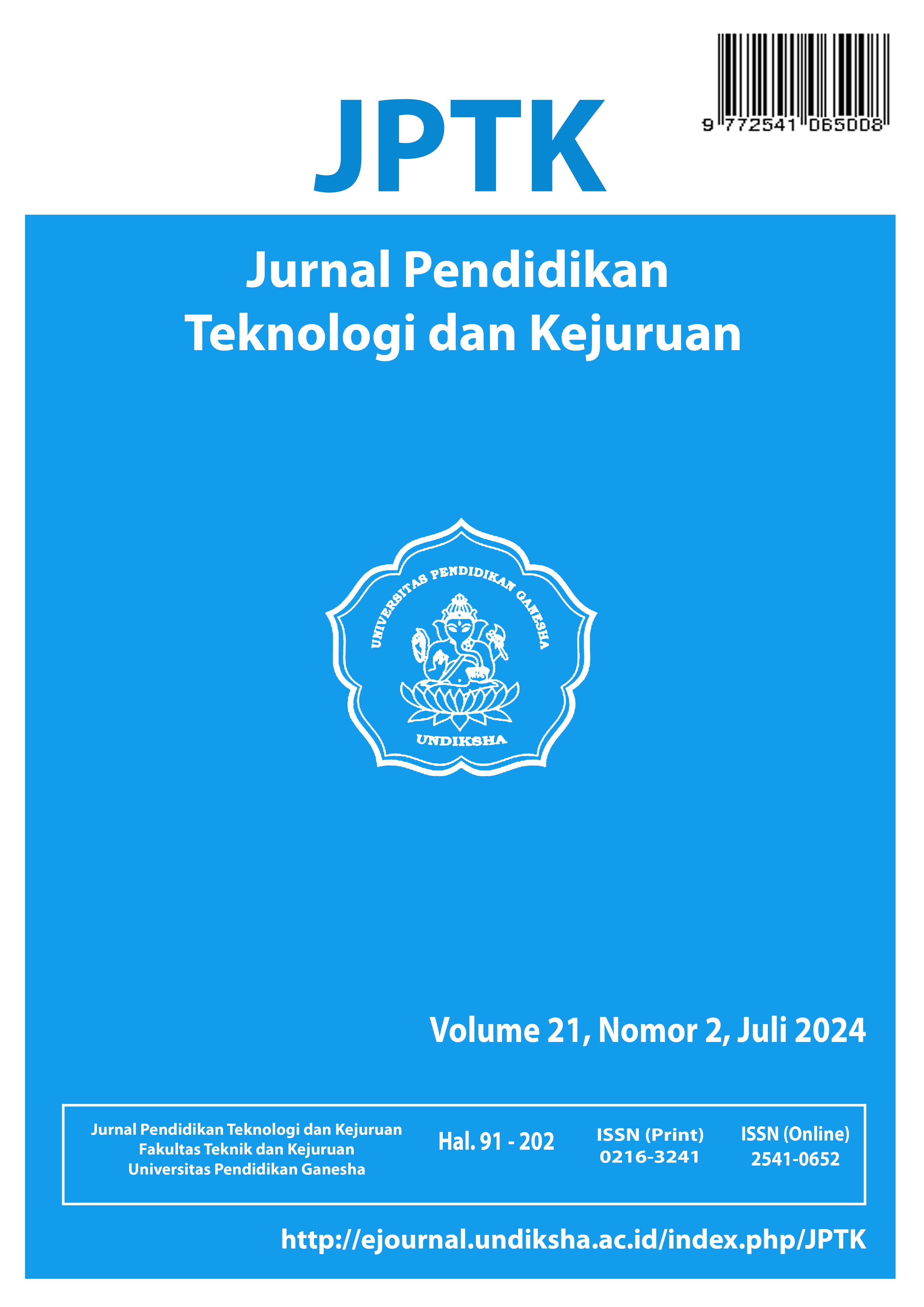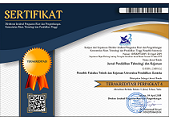DESAIN DATA CENTER PERBANKAN DENGAN METODE NETWORK DEVELOPMENT LIFE CYCLE (NDLC) (STUDI KASUS PT. BPR XYZ)
DOI:
https://doi.org/10.23887/jptkundiksha.v21i2.76915Keywords:
Desain, Data Center, Perbankan, Security Technology ArchitectureAbstract
Perkembangan teknologi informasi telah menghasilkan berbagai produk dan layanan yang sangat dinamis mengikuti kebutuhan masyarakat termasuk dalam bidang perbankan. Untuk dapat menjalankan sistem elektronik ini, infrastruktur pusat data (data center) menjadi unsur penting yang harus dimiliki oleh institusi perbankan. Hal yang sama dibutuhkan oleh PT. BPR XYZ yang saat ini masih belum mengelola dengan baik pusat datanya. Kondisi topologi jaringan antar kantor saat ini belum baik sehingga perlu adanya topologi usulan. Perancangan keamanan data center dalam penelitian ini menggunakan framework Open Enterprise Security Architecture (O-ESA). Framework tersebut difokuskan pada penggunaan Security Technology Architecture pada bagian arsitektur layanan keamanan (security services). Metode yang digunakan dalam penelitian ini adalah Network Development Life Cycle (NDLC) sebagai acuan pada proses pengembangan keamanan data center di PT. BPR XYZ. Penelitian ini merekomendasikan desain jaringan antar kantor. Desain yang diberikan sudah melalui proses simulasi untuk membuktikan desain usulan lebih baik dari desain yang ada, sehingga desain usulan dapat diterapkan untuk keamanan data center pada PT. BPR XYZ. Pada topologi usulan menggunakan jaringan dedicated sebagai virtual private network (VPN) server dan pengamanan jaringan menggunakan traditional firewall. Topologi usulan mendukung high avalability dengan teknik failover.
References
P. D. G. and H. J. L. de S. A.F. Santos, “New Data Center Performance Index: Perfect Designs Data Center-PDD,” J. Clim., vol. October, 2020.
P. Taylor, Data Centers - Statistics & Facts. Statista. 2022. [Online]. Available: https://www.statista.com/topics/6165/datacenters/#topicOverview
O. Ayoub, O. Huamani, F. Musumeci, and M. Tornatore, “Efficient Online Virtual Machines Migration for Alert-Based Disaster Resilience,” 2019 15th Int. Conf. Des. Reliab. Commun. Networks, DRCN 2019, pp. 146–153, 2019, doi: 10.1109/DRCN.2019.8713760.
C.-Z. Hao, J., Ye, K., & Xu, “Live migration of virtual machines in OpenStack: A perspective from reliability evaluation,” 2th Int. Conf. Held as Part Serv. Conf. Fed. SCF 2019, San Diego, CA, USA, June 25–30, 2019, 2019, [Online]. Available: https://doi.org/10.1007/978-3-030-23502-4_8
B. Shi, H. Shen, B. Dong, and Q. Zheng, “Memory/Disk Operation Aware Lightweight VM Live Migration,” IEEE/ACM Trans. Netw., vol. 30, no. 4, pp. 1895–1910, 2022, doi: 10.1109/TNET.2022.3155935.
I. N. Somit Maloo, Networking technology, vol. 10, no. 5. 2022.
M. T. K. and U. Y. K. S. H. A.A. Wahdini Fatimah, “Network Traffic Data Center Based on TIA-942 Standard:A Case Study in Bogor Government Office,” J. Adv. Comput. Networks, vol. 8, p. 1, 2020.
M. Haranas, Gartner’s Data Center And Cloud Networking Magic Quadrant Leaders. 2020. [Online]. Available: https://www.crn.com/slide-shows/cloud/gartner-s-data-center-and-cloud-networking-magic-quadrant-leaders/3
F. Nafisah, W. Putra, and A. Herlambang, “Evaluasi Keamanan Informasi Data Center Berdasarkan Standar ISO 27001:2013 (Studi Kasus PT. Pupuk Kalimantan Timur),” J. Pengemb. Teknol. Inf. dan Ilmu Komput., vol. 4, no. 6, pp. 1858–1865, 2020, [Online]. Available: https://j-ptiik.ub.ac.id/index.php/j-ptiik/article/view/7441
M. T. K. I Gede Iswara Darmawan, “Desain Dan Analisis Best Practice Physical Security Dan Logical Security Pada Data Center Fakultas Rekayasa Industri Universitas Telkom Menggunakan Standar Tia-942 Dan Open Enterprise Security Architecture Design and Analysis of Best Practice Physical Sec,” vol. 2, no. 2, pp. 5576–5586, 2015.
M. McClintock, K. Falkner, C. Szabo, and Y. Yarom, “Enterprise security architecture: Mythology or methodology?,” ICEIS 2020 - Proc. 22nd Int. Conf. Enterp. Inf. Syst., vol. 2, no. Iceis, pp. 679–689, 2020, doi: 10.5220/0009404406790689.
R. M. Hicks, Implementing Always On VPN. 2022. doi: 10.1007/978-1-4842-7741-6.
F. Ardianto, “Penggunaan mikrotik router sebagai jaringan server,” Pengguna. Router Mikrotik, vol. 1, no. 1, pp. 26–31, 2020.
J. Wardana, M. A., Nusri, A. Z., & Juliandika, “Jaringan Virtual Private Network (VPN) Berbasis Mikrotik pada Kantor Kecamatan Marioriawa Kabupaten Soppeng,” J. Ilm. Sist. Inf. dan Tek. Inform., vol. 5(2), pp. 107–116, 2022, [Online]. Available: https://doi.org/10.57093/jisti.v5i2.135
A. S. Satryawati, E., Pangestu, D. A., & Budiman, “Implementasi virtual private network menggunakan point-to-point tunneling protocol,” JEIS J. Elektro dan Inform. Swadharma, vol. 2(1), pp. 36–42, 2022, [Online]. Available: https://doi.org/10.56486/jeis.vol2no1.160
N. Anwar, R. S., & Agustina, “Implementasi dan Analisa Kinerja Jaringan Wide Area Network dengan Open VPN-Access Server,” Informatics Educ. Prof. J. Informatics, vol. 4(2), pp. 143–152, 2020, [Online]. Available: https://doi.org/10.51211/itbi.v4i2.1307
A. Faizah, S., Pudjiarti, E., & Saryoko, “Perancangan Jaringan Dengan Menggunakan Static Routing Dan VPN PPTP Pada SMK Bina Putra,” Bina Insa. ICT J., vol. 9(1), pp. 53–62, 2022.
T. C. Hall, Check Point Firewall Performance Optimization-Independently. Max Power, 2020.
Downloads
Published
Issue
Section
License
Authors who publish with the JPTK agree to the following terms:- Authors retain copyright and grant the journal the right of first publication with the work simultaneously licensed under a Creative Commons Attribution License (CC BY-SA 4.0) that allows others to share the work with an acknowledgment of the work's authorship and initial publication in this journal
- Authors are able to enter into separate, additional contractual arrangements for the non-exclusive distribution of the journal's published version of the work (e.g., post it to an institutional repository or publish it in a book), with an acknowledgment of its initial publication in this journal.
- Authors are permitted and encouraged to post their work online (e.g., in institutional repositories or on their website) prior to and during the submission process, as it can lead to productive exchanges, as well as earlier and greater citation of published work. (See The Effect of Open Access)












